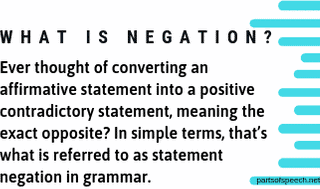Negation in English Grammar with Examples [PDF]
In today’s lesson of English Grammar we are going to discuss on What is Negation in English Grammar, a different form of negation, also we will discuss on the scope of negation with some relatable examples, so let’s jump into the article. To download the lesson in PDF format, please find the downloadable link attached below in the article.

Ever thought of converting an affirmative statement into a positive contradictory statement, meaning the exact opposite?
In simple terms, that’s what is referred to as statement negation in grammar.
For example,
- That’s a nice dog – That’s NOT a nice dog.
Verbs can be negated as well. You simply add the word “NOT” after the modal [External Link] or auxiliary and the meaning of the statement changes to its exact opposite.
- She does play football – She does NOT play football.
- You’re supposed to sleep early today – You’re NOT supposed to sleep early today.
- I will visit Canada this coming month – I will NOT visit Canada this coming month.
So, to put it quite simply, sentence negation can be defined as the process of expressing a particular sentence in the exact opposite. Negations, on the other hand, are the negative words that offer the opposite meaning and they include words such as NO, NEVER, or NOT.
Understanding sentence negation is NO rocket science. All you’re required to do is figure out the most appropriate way to add a negation to the statement and that’s it.
For instance, to turn the statement “I’m coming” into a negative statement, you simply add NOT between the “I’m” in the statement and the “coming.”
- I’m NOT coming.
The different forms of Negation:
Negation can come in different forms. In Standard English, the most common form of negation is the use of the functional word “NOT” or its contracted version is n’t.
Other forms of negative words you can use to express a statement in its exact opposite include no, nowhere, none, never, and nowhere to name a few.
In some cases, you can formulate a negative statement of a word by adding the prefix un- before a positive word to mean the exact opposite. Examples include happy to unhappy, decide to undecide, tidy to untidy, and so forth.
Other forms of negative affixes include a-, dis, de-, -less, mis, and in-. And examples include able to disable, clutter to declutter, allow to disallow, capable to incapable and so forth.
The first one could be that the speaker is refuting the claim that they ever tried calling you.
Another one could that the speaker is refuting the claim that they tried calling you by the name sweetie.
Or it could be that the speaker is calling someone else.
And so forth.
So to define, the scope of negation is the process of figuring out what exactly is being negated in a statement – and it always varies depending on the subject, the context, background information, and the speaker’s assertion.
Examples in a sentence:
- I’m barely surviving.
- She hardly sends her mum any money.
- He scarcely avails himself even to his own children.
Also worth noting are the negations that also double as verbs. Examples include doesn’t, haven’t, shouldn’t, won’t, can’t, don’t, couldn’t, and wouldn’t to name a few.
Double Negatives:
Every time you’re using a negative word, it’s crucial that you limit your use to only one negative per statement. Otherwise, you’ll be committing a grave grammatical error of double negative.
Double negative can be defined as the use of two negatives in one sentence or statement. In which case, a negative statement automatically turns into a positive one.
Double negatives are discouraged because they’re confusing and therefore passed as poor grammar. They’re however common in song lyrics, poetry, and informal conversations.
Examples in a sentence:
- Dating her can’t do you no harm.
- Isn’t somebody cared of nobody?
- I can’t find my dog nowhere?
- She’s never trusted nobody.
Double Negative with Prefixes:
It’s possible to formulate a double negative statement using a prefix ir, un, non, dis, or in. Here are common examples:
- The evidence gathered so far are not irrefutable.
- I won’t allow myself to be disrespected.
- The ending is NOT inconclusive.
- She wasn’t as irresponsible as reported.
Double negatives with adverbs:
Double negative can be formulated using negative adverbs in a sentence.
- I can’t barely get by.
- I’m NOT scarcely available as accused.
- I don’t go swimming seldom.
Scope of Negation:
The English language is complex and every negative statement made have several layers to it, each of which plays to a meaning that’s entirely different from the next one.
Take this sentence for example:
- She didn’t call you sweetie.
This statement alone is enough to send you into a complicated mental process trying to figure out what’s being implied by the speaker.
The first one could be that the speaker is refuting the claim that they ever tried calling you.
Another one could that the speaker is refuting the claim that they tried calling you by the name sweetie.
Or it could be that the speaker is calling someone else.
And so forth.
So to define, the scope of negation is the process of figuring out what exactly is being negated in a statement – and it always varies depending on the subject, the context, background information, and the speaker’s assertion.
Recommended Video on Negation:
So this all about this lesson Negation, I hope you are able to understand the lesson, if you sill has any doubts, do not forget to comment down below with your doubts.